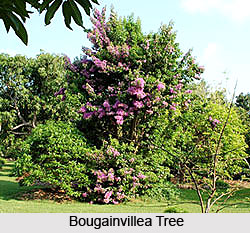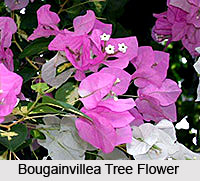 The tree that derived from the family of `Nactaginaceae` and quite famous as a garden tree is named as the `Bougainvillea Tree`. It is also called as `Paper Flower` in English. This tree is one of the most prominent and colourful features of Eastern gardens. They can make marvelous boundary hedges and fences. People clipped the tree to suitable dimensions and they also make perfect pot plants by the tree. They are a beautiful sight over an arch or spectator area.
The tree that derived from the family of `Nactaginaceae` and quite famous as a garden tree is named as the `Bougainvillea Tree`. It is also called as `Paper Flower` in English. This tree is one of the most prominent and colourful features of Eastern gardens. They can make marvelous boundary hedges and fences. People clipped the tree to suitable dimensions and they also make perfect pot plants by the tree. They are a beautiful sight over an arch or spectator area.
While left to walk through a sprawling tree they give their host the appearance of being in constant bloom. Their colours vary from magenta and purple to crimson. They can also take the colours of brick red, pale pink, salmon and yellow. A white variety has recently been found in India. The tones of the magenta varieties are rather clamorous. They are suitable enough to clash with other flowers and remain at their best against a background of green, or even better against a clear blue sky. The segments of the tree that we think to be the flowers are in fact trios of bright coloured bracts that surround the true flowers. These flowers usually stay in threes. They are small and like tubes in shape. Each of them partly adheres to the base of a bract. The long and ridged calyx tube is greenish or cream-coloured. It is often traced with the colour of the bracts and opens at the end into a little, ruffled flower. The flower is either white or yellow in colour.
The stems of the tree are armed with spikes that assist the plant in its climbing and sprawling and the leaves are simple and alternating. There are countless varieties of the `Bougainvillea Tree` and a host of hybrids, all of which it would be impossible to describe. There have been several occasions when the same variety has been introduced into gardens in different parts of India under different names. Each of these hybrids has been produced and the result has been great confusion. The result of this confusion is that a lot of valid varieties have got three or four names each.
 All the known varieties of the `Bougainvillea Tree` have derived from four species and they are either smooth or hairy leaved. The varieties are `B. Spectabilis`, `B. Glabra`, `B. Peruviana` and `B. Buttiana`. Amongst them, `B. Spectabilis` is more energetic and has purple or rose-purple bracts. The bracts are about 3.8 cm in length. The flower heads are grouped at the end. Sometimes they sprout from the sides of the branches. The leaves grow alternately here. They bear a short stem and they are oval in shape. They have a slightly pointed tip sometimes and they are a bit hairy. The specie, `B Glabra` has magenta bracts, but the leaves are soft, oblong and bright green in colour. The whole plant is less hairy and is more popular in some districts as it flowers almost endlessly all through the year. There are several varieties of this specie that differ only slightly in the shade of the bracts and in the size of the flower panicles.
All the known varieties of the `Bougainvillea Tree` have derived from four species and they are either smooth or hairy leaved. The varieties are `B. Spectabilis`, `B. Glabra`, `B. Peruviana` and `B. Buttiana`. Amongst them, `B. Spectabilis` is more energetic and has purple or rose-purple bracts. The bracts are about 3.8 cm in length. The flower heads are grouped at the end. Sometimes they sprout from the sides of the branches. The leaves grow alternately here. They bear a short stem and they are oval in shape. They have a slightly pointed tip sometimes and they are a bit hairy. The specie, `B Glabra` has magenta bracts, but the leaves are soft, oblong and bright green in colour. The whole plant is less hairy and is more popular in some districts as it flowers almost endlessly all through the year. There are several varieties of this specie that differ only slightly in the shade of the bracts and in the size of the flower panicles.
The `B. Peruviana` specie of the `Bougainvillea Tree` has smaller and mauve-pink coloured bracts. The flowers are yellowish in colour and the leaves are large and smooth. A deep pink variety of this specie is given the names of `Ecuadorian Pink`, `Lady Hudson` and `Princess Margaret Rose`. The hybrid `B. Buttiana` is considered to be a cross between `B. Glabra` and `B. Peruviana`. It has crimson coloured bracts and some broad and rather hairy leaves that are of coppery orange colour that turns to crimson-purple and dark green. It is a beautiful plant and it contains some close branches of flowers it is deservedly popular.
The specie named as `B. Formosa` has solid clusters of pale magenta-pink flowers. The flowers continue to bloom through the Rainy season, but become quite untidy, as many flowers remain in the cluster after they have become dead and dry. There are two kinds with multicolored leaves that are green marked with cream. The `Bougainvillea Tree` grows very easily in any soil. It can thrive with little attention.
However, with judicious clipping and watering, the form of the plant and quantity of bloom can be controlled. It is perhaps at its best in India at altitudes between 600 and 1200m. It grows wonderfully in many of the subtropical countries.











